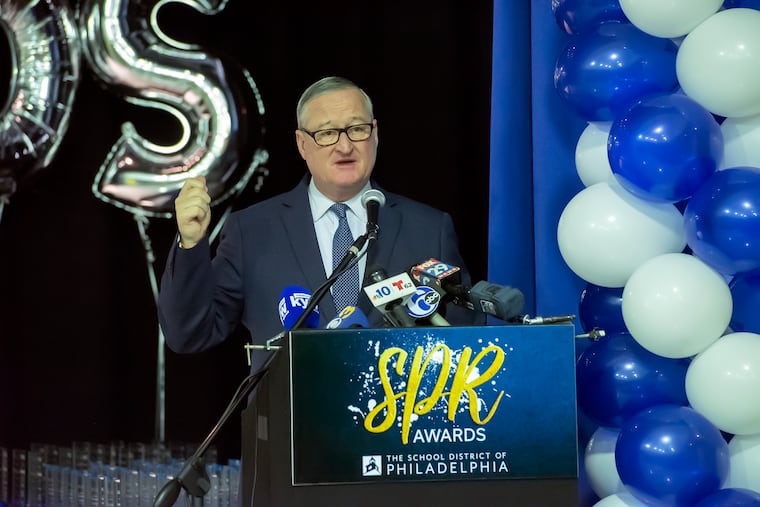Which are the best, most improved Philly schools? District reveals them.
As a group, district and charter schools in 2018-19 scored a 44 out of 100 on the School Progress Report, or SPR, a system-created assessment, weighted heavily on improvement.

City schools continued their slow but steady improvement based on the district’s measurements over the past year, with more schools ranked in the top-performing tier and fewer in the bottom tier. But roughly two-thirds of the district’s students in third grade and above still do not meet state standards in English language arts or math.
That information was unveiled Monday during a presentation at Hunter Elementary in North Philadelphia as the Philadelphia School District released its annual report cards for schools — 216 traditional public and 87 charters. (One charter, West Philadelphia Achievement Charter, did not participate.)
“This is a story of progress,” Superintendent William R. Hite Jr. said of the district’s trajectory. The School Progress Report average has risen incrementally, but steadily since the measure was created.
As a group, district and charter schools in 2018-19 scored an average of 44 out of 100 possible points on the School Progress Report (SPR), a district-created assessment, weighted heavily on improvement, that takes into account academics, climate, and, for high schools, college and career readiness. The prior year, the average was 42. The district did not provide separate overall scores for district and charter schools.
Citywide, the average school score has jumped 11 points since the SPR was introduced in 2014-15, when the average was 33. Over those five years, the district has seen the number of schools in its top two tiers grow to 127 from 61. At the same time, 50% fewer schools are in the lowest category — 56, down from 112.
Still, the majority of district students in third through eighth grade do not meet state standards in English language arts or math. District-wide, 36% of children scored proficient or advanced in English, and 22% in math. And at the high school level, 19% of students passed the Algebra I Keystone exam and 36% passed the literature exam. The district’s graduation rate stands at 69%.
» READ MORE: Read more: The 2019 top SPR schools
Schools land in one of four tiers — “model,” with scores 75-100; “reinforce,” 50-74; “watch,” 25-49; and “intervene,” 0-24. Schools in the intervene category can be placed in the district’s acceleration network, and receive extra support and scrutiny, with a school overhaul possible if progress isn’t made quickly enough.
Those schools recognized included Penn Alexander Elementary in West Philadelphia, which was lauded for having the highest overall SPR score; George W. Nebinger School, Philadelphia Academy Charter, James Logan School, and Parkway Northwest, for highest year-over-year improvement; and F. Amedee Bregy School, Franklin Towne Charter High School, William M. Meredith School, Feltonville School of Arts and Sciences, and Maritime Academy Charter School, for highest four-year growth.
“Students’ futures are brighter because of this progress, and our city is better off,” Mayor Jim Kenney said at Hunter, where students began Monday’s ceremony with a drum line and sing-along to “Eye of the Tiger.”
Saying education is the “most important thing we do as a government,” Kenney took a swipe at President Donald Trump, praising Hunter as “this wonderful ‘government school’” — as opposed to the “failing government schools” Trump criticized last week while promoting school choice.
Malika Savoy-Brooks, the district’s chief of academic supports, acknowledged the progress.
“I think we’re going in the right direction, but no, I’m not happy. We have a lot of work to do,” she said.“I will be happy when the majority of our schools are at 100%.”
Most Philadelphia schools have improved in every domain, with the most marked increases in climate scores, which measure things such as attendance, suspensions and parent engagement based on the percentage of parents who participate in a school survey.
Karyn Lynch, the district’s chief of student support services, said the increase in overall school climate is a bellwether of improvement to come.
“You really have to have good climate within your schools before you’re going to see the progress and the academic achievement that you want to see,” Lynch said.
Since growth counts significantly toward a school’s score, schools that start with high scores, like Central and Masterman, have a much tougher time landing on the list of SPR standouts.
Principals who have overseen improvements credited the gains to a variety of factors: from community partnerships bringing resources into their schools, to an emphasis on professional development for teachers and activities and clubs geared to bolster student enthusiasm and attendance.
“There’s not one puzzle piece that’s more important than the other,” said Roslynn Sample-Green, principal of Franklin Elementary in Crescentville, which improved its score to 53 from 40 last year. Like other principals, she credited the efforts of staff: “Everybody is grinding at the same time.”
At Hunter, a neighborhood school of 600 students in pre-K to eighth grade that was recognized for three years of improving scores, principal Heather Mull Miller said school staff had worked to reduce suspensions and emphasize reading, with children spending 30 minutes reading books of their choice each day. “We try really hard to make sure they love it here,” she said.